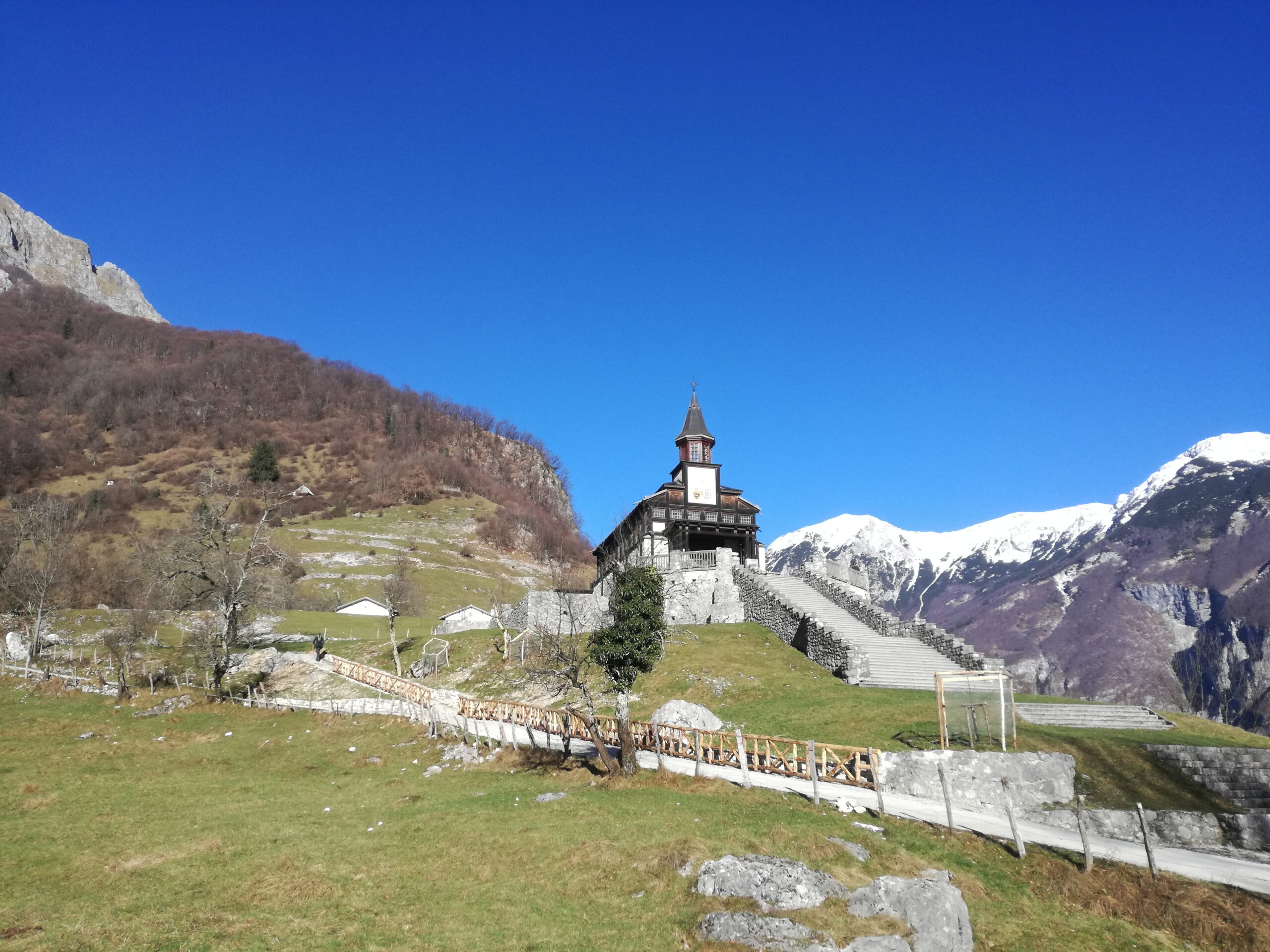
Memorial Church of the Holy Spirit in Javorca. ©Damjana Fortunat Černilogar
The Memorial Church of the Holy Spirit in Javorca has persisted for more than a century in a beautiful natural environment. The Tolmin Museum has re-evaluated this remarkable cultural monument and presented it to the wider European public through a travelling exhibition, a monograph, online exhibitions, lectures and other promotional activities.
The wish of the monument’s designers to preserve the monument for future generations has been realised. It has been a difficult journey to achieve this goal, adapting to different regimes, views, and attitudes towards the monument, which have changed in different countries and regimes. The church, built in Javorca during WWI, was handed over to the Tolmin parish after the end of the war. Today, it is part of the Triglav National Park, is owned by the Municipality of Tolmin, and various religious communities still hold worship services there every year.
The Memorial Church in Javorca was built in 1916 by the soldiers of the 3rd Mountain Brigade of the 15th Austro-Hungarian Corps with voluntary work and their own funds. The Isonzo Front, which was established at the end of May 1915, already took many casualties in the first year of fighting. Soldiers on both sides, looking at the numerous military cemeteries after several months of fighting, strongly wanted peace. They wanted to build a permanent memorial to the fallen. In December 1915, the soldiers of the Austro-Hungarian army were called upon to collect ideas. From the many designs, the best idea by the Viennese artist Remigius Geyling was chosen. It was thought that after the war, the local parish would be able to take care of the church as he had envisioned it. They wanted the monument to serve another purpose, not just a symbolic one.
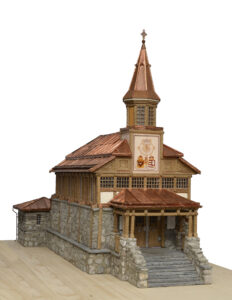
Model of the Memorial Church in Javorca, made by Franc Pogačar. ©Marko Grego, Tolmin Museum
First, they carefully chose a location equidistant from the nearest battlefields. Geyling even speculated on the origin of the local name Javorca. The origin of the name can be traced back to the word maple (javor). The maple tree, which is present in the area, is a sacred tree according to an old folk tradition.
The site in Javorca was laid out in March 1916 and the foundation stone was laid on 4 April. At the time of construction, an average of 32 soldiers were building the facility. In addition to the plan for the church, Geyling also worked out various details. Géza Jablonszky from Budapest supervised the construction work, while the Tyrolean woodcarver Anton Perathoner made many of wooden details. The church was dedicated to its purpose on 1 November 1916. Catholics, Protestants, Orthodox, Jews, Muslims and some atheists have all visited the church.
The exterior of this remarkable Art Nouveau sacral building is decorated with the stylised coats of arms of the Austro-Hungarian Empire, while the bell tower features the inscription Pax (Peace). Inside, the visitor is overwhelmed by a sense of sacredness with the perfect balance of the dominant colours and shaken by the sight of the 2,565 incensed names of Austro-Hungarian soldiers of various nationalities and religions who fell at Vodil vrh, Mrzli vrh, Rdeči rob and Sleme.
The Memorial Church has had its ups and downs since the end of the WWI. It has survived three changes in national borders and two totalitarianisms. The first comprehensive renovation was carried out by the Italians, who, at the time of the fortification of the Rapallo border between the Kingdom of Italy and Yugoslavia, added the inscription ‘Beyond the ash the anger of the enemies subsides’ at the entrance. After the WWII, the church was first cared for by a local man from a nearby farm, then it was left to the ravages of time. Pressure from the public and the parish priest of Tolmin contributed to a second major renovation in the 1980s. It was not spared by the 1998 earthquake. A third major renovation took place in 2004/2005. To mark the centenary of its construction, the interior has been refreshed by restorers. In recent years, the bell tower and part of the roof have been renovated, and the surrounding area has been landscaped.
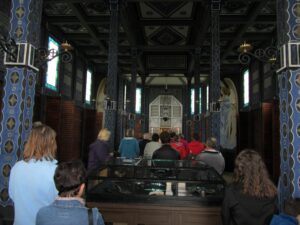
Mass for Peace in Memorial Church in Javorca, September 2018. ©Damjana Fortunat Černilogar
In the meantime, the Tolmin Museum carried out extensive research and, on the basis of the Geyling family archive, which was later donated to the museum, prepared a high-profile travelling exhibition, The Memorial Church of the Holy Spirit in Javorca – one hundred years of the “Basilica of Peace”. The exhibition, first presented in Tolmin in 2016, was a good basis for the successful nomination of Javorca for the European Heritage Label (2017). In November 2016 it toured Vienna and continued its journey to Gorizia (2016-2017). During our 2018 visit to Villach, we were already proud to present the Memorial Church as a bearer of the European Heritage Label (EHL). In the European Year of Cultural Heritage 2018, the exhibition continued its journey to Prague and at the end of the year to Rijeka (2018–2019), and in September 2021 to Idrija.
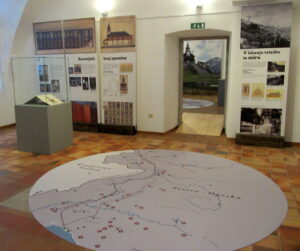
A part of the Tolmin Museum touring exhibition about Javorca. ©Damjana Fortunat Černilogar
Through its activities, the Tolmin Museum has contributed to raising awareness in the local and wider European community of the greatness of the monument and the European values it expresses. In the framework of the EHL holders Networking Project (EHL@N), in which it participated on behalf of the Municipality of Tolmin, it placed Javorca alongside the 48th EHL sites on the web, social networks and in comics.
Javorca Memorial Church was built in difficult circumstances when solidarity and religious tolerance came to the fore. Mutual respect, cooperation and integration are also important in today’s turbulent times. And it is precisely the message of peace and the importance of solidarity in times of hardship that we want to pass on to young people. The cooperation of the Tolmin Museum, the Municipality of Tolmin and the Tolmin Association of Artists has resulted in the creation of the colouring book Javorca, which appeals to the general public through its story with a universal artistic language. The Tolmin Museum has also included the memorial church in its permanent exhibition and educational programme. A remarkable tool for this is the 1:20 scale model of the church, acquired in 2021. During the Covid19 epidemic, our activities were limited, so we took some of our content online. The Museum’s website features an online exhibition in four languages, The Memorial Church of the Holy Spirit in Javorca – “Basilica of Peace” (http://www.tol-muzej.si/javorca/en/). The KAMRA portal hosts the online exhibition Javorca 1916-2016 (https://www.kamra.si/digitalne-zbirke/javorca-1916-2016/).
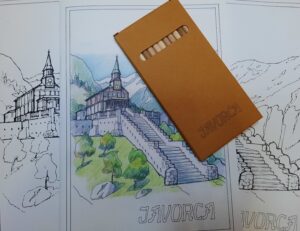
Colouring book Javorca. ©Damjana Fortunat Černilogar
As the church is located within the Triglav National Park and is accessible by a narrow road, the location cannot withstand mass tourism. This is one of the reasons why we wanted to bring Javorca closer to a wider audience, including through digital content. Our activities have also contributed to increased in situ visitations, which undoubtedly provide a more authentic connection with the surroundings and nature. The Municipality of Tolmin and the Soča Valley Tourist Board, therefore, organise public transport during the summer months, thus limiting traffic.
The church has retained its original purpose and is used for four Catholic masses each year, which are also attended by local people. At the end of June, they also respond to an invitation from the Serbian Orthodox Church congregation for an Orthodox Mass.
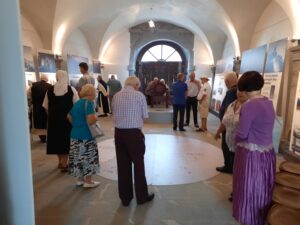
Exhibition The Memorial Church of the Holy Spirit in Javorca – “Basilica of Peace”, hosted by Slovene Museum of Christianity in Stična. ©Damjana Fortunat Černilogar
Javorca Memorial Church connects us and becomes a meeting place. It is often visited by delegations from abroad. Javorca and the Tolmin Museum are particularly linked to the closest bearer of the Label, the Franja Partisan Hospital (2015) and the Idrija Municipal Museum, which manages it. The first cooperation dates back to 2018 when we gathered representatives of EHL sites and the three national coordinators in Cerkno and Tolmin and visited both cultural monuments. In 2021, we connected the Memorial Church and the Partisan Hospital in a unique way by exchanging two temporary exhibitions between the Tolmin Museum and the Idrija Municipal Museum.
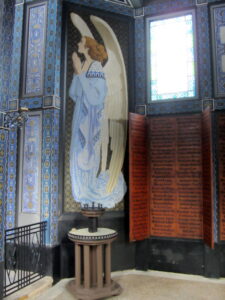
Part of the wall with names on the oak panels and an angel. ©Damjana Fortunat Černilogar
As part of the European Heritage Days 2021, we also designed the project Javorca and Franja – when humanity wins and organised the Open Days at the end of September. Together we invited people to Franja and Javorca, and to visit museum exhibitions in Idrija and Tolmin.
We have also been involved in other European initiatives. For International Museum Day 2021, the Tolmin Museum prepared a poster for ICOM Slovenia’s urban exhibition in Ljubljana. In the case of Javorca, we highlighted Education and Digital Transformation. In 2021, we organised the European Heritage Label exhibition in the castle park in Tolmin and then in Javorca, which was prepared by the European Commission and brought the 48 EHL holders closer to the wider local community and tourists.
The director of the museum also actively participated in the meetings of the EHL sites in Brussels (2019, 2022), where she presented Javorca to the participants and the activities within the EHL project that we are carrying out together with the Municipality of Tolmin and the Soča Valley Tourism Institute.
Let me conclude with the news that this year the Tolmin Museum is presenting the exhibition about Javorca in the Museum of Christianity in Slovenia, which is housed in the former premises of the still functioning Cistercian monastery of Stična. It is a cooperation with the Museum, which together with the Božidar Jakac Gallery in Kostanjevica na Krki, operating in the former Cistercian monastery, together with the partners of the CISTERSCAPES project, is applying for the European Heritage Label.
And we will continue to do our utmost to preserve this remarkable cultural monument in Javorca, a symbol that calls for reconciliation, solidarity and tolerance.
We invite you to Tolmin and Javorca and to reflect on the eternal fragility of peace!
By Damjana Fortunat Černilogar, Tolmin Museum Director
http://www.tol-muzej.si/javorca/en/ | https://www.javorca.info/
Translation: K&J Translations





Follow us: